|
When looking for that just “before
Christmas and all through the house”
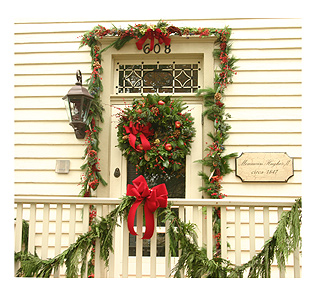 fragrance,
I turn to the garden. When winter approaches
and the hours of daylight become less each day, I feel the necessity to
be out-of-doors and to bring nature in. One solution has always been to
take a winter walk to collect materials for holiday decorations. My
earliest recollections of these foraging adventures go back to childhood
when my Dad would take my brother, sister and I out to gather greens for
wreaths and small woodland plants for terrariums. fragrance,
I turn to the garden. When winter approaches
and the hours of daylight become less each day, I feel the necessity to
be out-of-doors and to bring nature in. One solution has always been to
take a winter walk to collect materials for holiday decorations. My
earliest recollections of these foraging adventures go back to childhood
when my Dad would take my brother, sister and I out to gather greens for
wreaths and small woodland plants for terrariums.
Winter gardens, fields and woods are like a banquet
table laden with colorful dishes. Leaves are gone, so bright berries,
cones and pods can be seen everywhere! Just this week we collected
evergreens and many kinds of berries around the nursery and fields.
The Berries of Winter
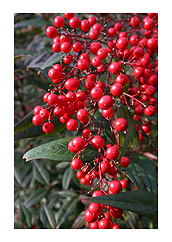 On a foraging walk you might find
holly berries. Bayberries, cedar berries, nandina berries and firethorn
berries. Then there are all the “berries” that are not called berries,
like rose hips, choke cherries, drupes and fruits of so many other
plants found in our gardens. Many of these are red! That makes them all
the more beautiful when used with shiny, fresh evergreens.
On a foraging walk you might find
holly berries. Bayberries, cedar berries, nandina berries and firethorn
berries. Then there are all the “berries” that are not called berries,
like rose hips, choke cherries, drupes and fruits of so many other
plants found in our gardens. Many of these are red! That makes them all
the more beautiful when used with shiny, fresh evergreens.
It is awesome collecting greens and berries and using them
in decorations this time of the year. I sit and write this just as I
have come in from the back porch of the shop where I have been
decorating wreaths with natural materials. The berries and pods
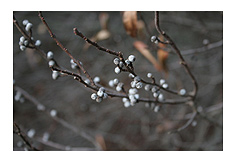 are
hot glued to wreaths with holly berries the most intense and beautiful.
The berries are so very abundant on the evergreen hollies this year that
I pluck off the leaves in order to showcase just the vibrant red or gold
berries. are
hot glued to wreaths with holly berries the most intense and beautiful.
The berries are so very abundant on the evergreen hollies this year that
I pluck off the leaves in order to showcase just the vibrant red or gold
berries.
Bayberries (myrica pensylvanica)
are a favorite that birds have spread all over in the overgrown area of
towering trees. We
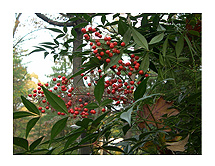 gather
these fragrant, gray/white waxy berries to use because they keep well gather
these fragrant, gray/white waxy berries to use because they keep well
and will dry and last for years. Glue
them to swags or wreaths for a
beautiful fragrant touch.
Nandina domestica does well in our garden and several plants
produce pretty colorful foliage and striking red berry clusters. These
showy, conical shaped bunches of berries are seen in Williamsburg
wreaths and arrangements.
Some other berries and fruits also look nice in arrangements and on
wreaths, but they do not last as long. That is why when I use crab
apples, persimmons or other fruits I try to keep the wreath or
arrangement either outside or in a very cool spot.
Subtle with deep russet hues, rose hips can be collected from many
types of roses and are a pretty berry cluster this time of the year.
Another attractive berry is the icy blue fruit of the native cedar
tree (juniper virginiana). An extraordinary blue in winter arrangements,
they keep well in fresh containers or on wreaths and swags. The cedars
that have the most berries are the ones found in sunny, sandy fields.
They too are relished by wildlife! A few dried hydrangeas, especially
blue ones look really wonderful near these berries in wreaths,
arrangements or garlands.
Of course the hollies are the brightest of all berries! Both
evergreen and deciduous holly berries are wonderful. Winter berry (ilex
verticillata) loses its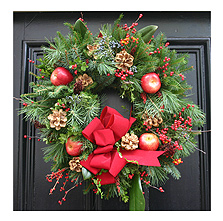 leaves to reveal outrageously beautiful red berries once the frost
claims its leaves. The most handsome stand of winterberry is across the
creek and only accessible by canoe, so now we planted them along this
side of the stream. (For years when our sons were growing up they
would take turns on wintry days paddling a canoe over so I could
precariously lean over into the shrubs and cut branches! Luckily we
never capsized!).
leaves to reveal outrageously beautiful red berries once the frost
claims its leaves. The most handsome stand of winterberry is across the
creek and only accessible by canoe, so now we planted them along this
side of the stream. (For years when our sons were growing up they
would take turns on wintry days paddling a canoe over so I could
precariously lean over into the shrubs and cut branches! Luckily we
never capsized!).
A favorite of blue birds,
brightly colored firethorn (Pyracantha) berries can’t be beat for
decorating. I start to use them around Thanksgiving along with small
gourds.
Dark red berry clusters from highland sumac adds a subtle elegant
look to evergreens. Rhus typhina (not the poisonous variety)
are beautiful added to wreaths or arrangements. These grow in vacant
lots, sandy dry fields or in a sunny well-drained landscape. The crimson
drupes seem to keep forever if the birds don’t get at them. I often
clusters left from Christmas collecting for spring Flower Show floral
arranging demonstrations.
Making the
Wreath
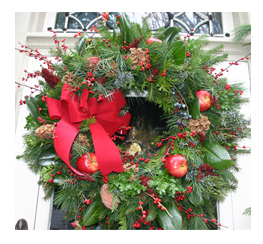 We start with a mixed greens wreath of fragrant concolor fir, spruce,
pine, cedar, and arborvitae. The decorations that are hot glued all
around the wreath include clusters of rose hips, sumac, holly, nandina,
persimmons, crabapples, bittersweet, wheat, black-eyed Susan seed heads,
apple slices, various cones, nuts, and pods. You can use the same
materials and glue them to a garland around the door or on a fence.
We start with a mixed greens wreath of fragrant concolor fir, spruce,
pine, cedar, and arborvitae. The decorations that are hot glued all
around the wreath include clusters of rose hips, sumac, holly, nandina,
persimmons, crabapples, bittersweet, wheat, black-eyed Susan seed heads,
apple slices, various cones, nuts, and pods. You can use the same
materials and glue them to a garland around the door or on a fence.
I can’t resist trimming this with a red velvet or plaid bow before
hanging it on our door. The birds often think it is an extension of the
feeder and so it is not unusual to see chickadees, titmice or even a
Cardinal posing on it. The wreath becomes a live Christmas card that
looks like it is right off a page of the National Wildlife card
catalogue. They are a nice winter decoration and can be moved to another
spot in the garden and left up till late winter.
Types of Fresh Greens
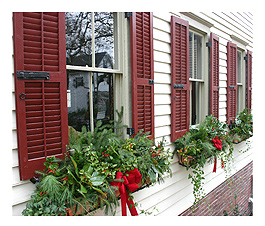 Most
evergreens can be picked during November and December to be used for
winter decorations. My very favorite evergreen is concolor fir.
It is gray green and has a wonderful citrus scent. It just makes you
feel wonderful when you use it and your hands smell so delicious! It is
a very long lasting green, like most firs, and looks excellent in
wreaths or arrangements. Most
evergreens can be picked during November and December to be used for
winter decorations. My very favorite evergreen is concolor fir.
It is gray green and has a wonderful citrus scent. It just makes you
feel wonderful when you use it and your hands smell so delicious! It is
a very long lasting green, like most firs, and looks excellent in
wreaths or arrangements.
Another extraordinary green that really adds charm to any
arrangement or wreath is the Hinoki false cypress. These vibrant
dark green branches are impressive and one of my very favorite greens to
use year round in arrangements.
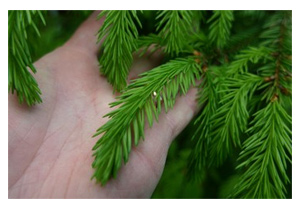 Although
all in the spruce family can be used, I like the bright green
Norway which is best for wreaths, as it is less bulky and seems to last
longer than some of the others. Blue spruce is pretty, but pinches and
lasts better on outdoor wreaths than inside. White pine is quite common,
but still one of the nicest to use in wreaths. It not only smells
wonderful, it lasts a long time. Although
all in the spruce family can be used, I like the bright green
Norway which is best for wreaths, as it is less bulky and seems to last
longer than some of the others. Blue spruce is pretty, but pinches and
lasts better on outdoor wreaths than inside. White pine is quite common,
but still one of the nicest to use in wreaths. It not only smells
wonderful, it lasts a long time.
Douglas fir is good because it is so easy to use as it is soft and
fragrant. However, keep in mind its color is not as vivid as some of the
others, so it looks best mixed with a variety of other greens.
I could never decorate in December without cutting bundles of
fragrant, graceful Arborvitae. As its name states, ‘tree
of life’ is a long lasting, aromatic addition to winter wreaths or
bouquets.
Shiny Magnolia leaves are for decorating! If you have evergreen
varieties use their shiny foliage to add another texture to needled
foliages on wreaths or in vases or bowls.
Greens used outdoors do not need to be in water. I heap branches in
an old wheelbarrow along the walk and also in an old wooden bucket by
the door and these keep well into spring!
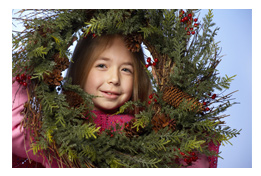 Making
Wreaths Then and Now Making
Wreaths Then and Now
I learned to make my very first wreath on vines twisted into a circle.
We eagerly waited to help when my Dad and Uncle Ed would make wreaths.
Later on as a grade school 4-H member I learned to make outstanding
wreaths on coat hangers that had been shaped into circles. Man has made
wreaths, the unbroken circle, a symbol of eternity, since ancient times.
Today they are still made in the same manner. Small bunches of plant
material are attached to a form in a circular style. I use a thin, yet
strong wire (#26) on a spool or small paddles.
There is no end to what you can do with wreaths. When our three
sons were old enough to learn to make wreaths, they started out using
coat hangers and later moved onto metal rings.
Last year I taught a handful of people how to make a wreath on a coat
hanger and realized that some things never change.
Lorraine Kiefer is the owner of
Triple Oaks Nursery, Florist and Herb Garden in Franklinville, NJ. If
you would like more information about what Lorraine has written about
please visit
www.tripleoaks.com. |